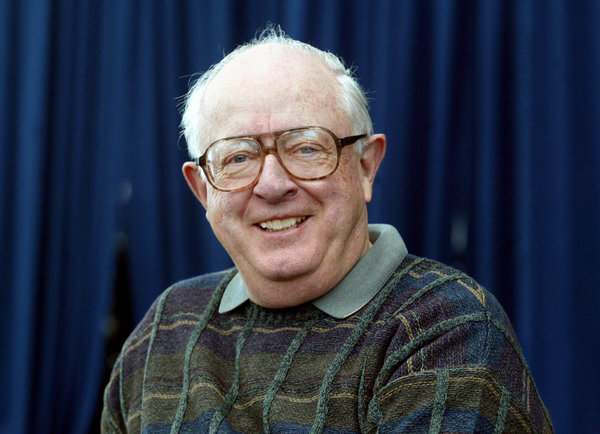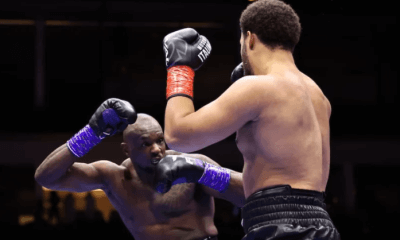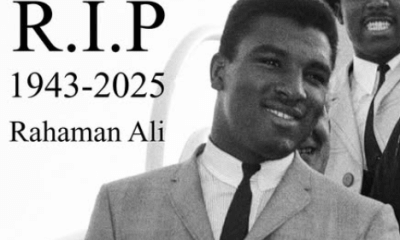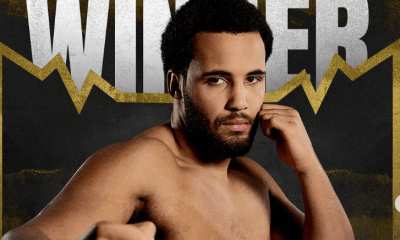Featured Articles
Sports World Loses Another ‘Ambassador of Niceness’ in Dave Anderson
In 1965 singer Jackie DeShannon had one of her biggest hits with a song entitled “What the World Needs Now is Love.” Well, the world still needs

In 1965 singer Jackie DeShannon had one of her biggest hits with a song entitled “What the World Needs Now is Love.” Well, the world still needs that, maybe more than ever. But while love remains in short supply, the cavernous void can be filled to some extent with another seemingly diminishing quality: niceness.
Just six days after boxing’s nicest and most widely beloved gentleman, Northern California promoter Don Chargin, took the eternal 10-count at 90, having grudgingly been outpointed by lung and brain cancer, the sports world was rocked by the news that another ambassador of niceness, Pulitzer Prize-winning former New York Times columnist Dave Anderson, had died on Thursday, Oct. 4, at an assisted-living facility in Cresskill, N.J. He was 89 and had been in failing health for several years.
But while those who knew them both, or at the very least admired them from afar, might acknowledge that they departed after long and well-spent lives, there remains a shroud of sadness that has descended on an American civilization that is becoming distressingly uncivil. Simply put, Chargin and Anderson cannot be replaced because they were throwbacks to another, almost-forgotten time when respect, courtesy and, yes, niceness humanized their ability to do their jobs with towering competence yet scarcely a trace of rancor.
Chargin, fight people know about, having been a licensed promoter in his home state for a record 69 years, during which he came to be nicknamed “War a Week” for the quality and quantity of bouts he staged on the Left Coast. But Anderson is probably more widely recognized, even in boxing circles, because of the huge platform afforded him by his Times column, elegant prose and the fact he was probably at ringside for nearly every truly major fight that took place anywhere on the planet for over five decades, until his retirement in 2007.
“I never heard anybody ever say anything bad about Dave, or him say anything bad about anybody, and we went just about everywhere,” Jerry Izenberg, 88, the columnist emeritus for the Newark Star-Ledger, said of his frequent traveling partner. “We went to the Philippines together (for Muhammad Ali-Joe Frazier III). We went to Zaire together (for Ali-George Foreman).”
But another former Times sports columnist, Harvey Araton, recalled at least one occasion when Anderson’s doggedly determined reportorial skills caused some of his readers to grumble about something he’d written.
“My favorite Dave story will always be how he sidled up to me at halftime of Game 2, Knicks-Bulls, ’93 conference finals, and I said, `Guy behind me is screaming at Michael Jordan for being out late in Atlantic City the night before,’” recalled Araton, who was covering the game in Madison Square Garden along with Anderson. “I told Dave, who said he’d look into it.
“By the next afternoon Dave had the time Jordan checked in, checked out and how much he’d lost playing blackjack. His column was largely blamed by Knicks fans for infuriating and inspiring Jordan and the Knicks losing four straight after winning the first two.”
But while Anderson was comfortable and knowledgeable in virtually every sports setting, he had an undeniable affinity for boxing. Among the 21 books he authored were In the Corner: Great Boxing Trainers Talk About Their Art and perhaps the definitive biography of the incomparable Sugar Ray Robinson, Sugar Ray. In 1981, when he became the second sports writer to win the Pulitzer Prize for Commentary, his citation noted six columns he’d written in 1980, one of which was entitled Muhammad Ali: The Death of a Salesman, which dealt with “The Greatest’s” beatdown at the hands of Larry Holmes in Las Vegas. Writing on a tight deadline, Anderson’s story began thusly:
As early as the first round, his age began to show. Muhammad Ali moved away from a left jab, but when he tried to throw a right hand at Larry Holmes, he missed awkwardly. And he never used to miss. By the fourth round, he was bleeding slightly from the left nostril. And he never used to bleed. In the fifth round, a shrill female voice interrupted the saddened silence that hung in the black desert night at the temporary arena in the Caesars Palace parking lot.
“Come on, Ali, fight,” that lonely voice beseeched him. But last night Muhammad Ali could not fight. He could not dance. He could not even punch. For several months he had promised a miracle in what had been billed as “The Last Hurrah.” It should have been titled “Death of a Salesman.” When the fight finally ended after the 10th round with Muhammad Ali plopped on the blue stool in his corner, a hush fell over the sellout crowd of 24,000 in the bleacherlike arena. All around the arena, people stood still the way they do at the funeral of someone who had died unexpectedly.
Anderson ended his take on what had to be considered the end of Ali’s remarkable era this way:
Usually a fight crowd files out quickly. But not this time. Most of the people just stood there, as if in shock. Some wept. Some blubbered. But at least Muhammad Ali had not had to endure the shame of being helped up off the canvas, as Joe Louis had the night Marciano demolished him. At least Muhammad Ali was sitting on his stool. And at least he would walk out of the ring under his own power.
“They should have stopped it five rounds earlier,” a man said. “They shouldn’t,” a woman answered, “have let it start.”
Dave Anderson’s destiny was almost preordained from birth. Born on May 6, 1929, in Troy, N.Y., his father was the advertising director of the The Troy Times, which his grandfather published. At 16, he landed his first newspaper job as a messenger for The New York Sun, where his father then worked in advertising sales. Shortly after Anderson’s graduation from the College of the Holy Cross in Massachusetts, he caught on with the Brooklyn Eagle, where he covered the Brooklyn Dodgers from 1953 to ’55, when the paper folded. He then moved to the New York Journal-American and was a sports staffer there when he won the E.P. Dutton Award for the best magazine sports story of 1965 for “The Longest Day of Sugar Ray,” which appeared in True magazine.
In 1966, Anderson went to the Times as a general assignment sports reporter until being promoted to columnist in 1971, a prestigious position he held until his retirement. In addition to his Pulitzer, he continued to add layers to his legacy of brilliant and prescient sports commentary, which included his induction into the National Sportscasters and Sportswriters Hall of Fame in 1990, the Associated Press Sports Editors (APSE) Red Smith Award for distinguished sports column writing in 1994, the Dick Schaap Award for Outstanding Journalism in 2005 and induction into the International Boxing Hall of Fame in 2006.
“The thing about Dave is that he was perfect for the Times,” Izenberg said of his friend and contemporary. “He wrote about controversial issues when he had to, but he was a guy who could really reach the Times readers. My voice is the voice of New Jersey, his was the voice of the Times. He understood for whom he wrote. And if you can’t do that, you shouldn’t be a columnist.”
Dave Anderson’s guy-next-door commonality– “People talked to him because he was self-assured and polite,” Araton said – was accentuated by his professional grace under pressure, qualities which are not mutually inclusive. He was particularly fond of the occasion he covered a New York Rangers game in Montreal for the Journal-American in 1956. Headed back to New York City on a train, he tossed game stories by the New York sports writers to a Western Union telegrapher standing by the tracks as the train slowed at the border at Rouse’s Point, N.Y.
“It’s in the middle of the night, it’s snowing and I’m standing between cars in the dark and toss the package of stories to him and hope somehow he teletypes the copy and it all gets in the newspapers,” Dave recalled in 2014.
In the morning, he picked up a copy of the Journal-American at Grand Central Terminal and “there was the story,” he said. “It was exciting. Even now, when I’m writing (he continued to contribute occasional stories to the Times after his retirement), I wake up on a Sunday and still get excited if I’m in the paper.”
It was my privilege to call Dave Anderson my friend and a role model, much as was the case with other now-deceased giants of a profession that has become microwaveable, a journalistic drive through the fast-food lane in which Twitterized abbreviations have replaced attention to detail and an appreciation of the power and majesty of the written word. His passing has struck me as hard as did the deaths of fellow sports writing legends Peter Finney, Edwin Pope, and Stan Hochman, as well as that of one of my favorite interview subjects, the perpetually personable Don Chargin. The circle continues to be drawn tighter and tighter, with Jerry Izenberg maybe the last sentinel of an era that is beyond replication. I hope he lives forever.
“Young people going into sports writing now, virtually all of them want to wind up on television,” Jerry said. “You’ve got people on TV offering `expert’ commentary on events that took place before they were born, but they’ve got the right kind of hairspray.”
Dave Anderson, a longtime resident of Tenafly, N.J., whose wife of 60 years, Maureen, died in 2014, is survived by sons Stephen and Mark, daughters Jo and Jean-Marie Anderson; three grandchildren; and one great-grandson.
Bernard Fernandez is the retired boxing writer for the Philadelphia Daily News. He is a five-term former president of the Boxing Writers Association of America, an inductee into the Pennsylvania, New Jersey and Atlantic City Boxing Halls of Fame and the recipient of the Nat Fleischer Award for Excellence in Boxing Journalism and the Barney Nagler Award for Long and Meritorious Service to Boxing.
Check out more boxing news on video at The Boxing Channel
-

 Featured Articles4 weeks ago
Featured Articles4 weeks agoThe Hauser Report: Zayas-Garcia, Pacquiao, Usyk, and the NYSAC
-

 Featured Articles3 weeks ago
Featured Articles3 weeks agoOscar Duarte and Regis Prograis Prevail on an Action-Packed Fight Card in Chicago
-

 Featured Articles2 weeks ago
Featured Articles2 weeks agoThe Hauser Report: Cinematic and Literary Notes
-

 Book Review2 weeks ago
Book Review2 weeks agoMark Kriegel’s New Book About Mike Tyson is a Must-Read
-

 Featured Articles4 weeks ago
Featured Articles4 weeks agoRemembering Dwight Muhammad Qawi (1953-2025) and his Triumphant Return to Prison
-

 Featured Articles7 days ago
Featured Articles7 days agoMoses Itauma Continues his Rapid Rise; Steamrolls Dillian Whyte in Riyadh
-

 Featured Articles3 weeks ago
Featured Articles3 weeks agoRahaman Ali (1943-2025)
-

 Featured Articles3 weeks ago
Featured Articles3 weeks agoTop Rank Boxing is in Limbo, but that Hasn’t Benched Robert Garcia’s Up-and-Comers


















